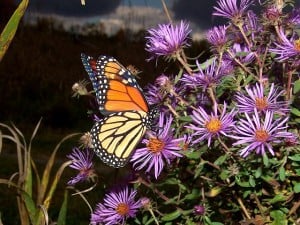6 May 2015 | Author: Chip Taylor, Director, Monarch Watch
If there were such a thing as Monarch Futures* on the market right now, I’d buy all I could. The immediate future for monarchs looks bright – there is a good chance the population will increase this year. Last year during the first week of May I predicted the monarch population would increase in 2014 and it did. The total area of trees occupied by monarchs in Mexico (1.13 hectares) was less than expected but it was still an improvement over the all-time low recorded in the winter of 2014 (0.67 hectares). Fortunately, during the overwintering period (November-March) for both years the weather was relatively normal and the monarchs wintered well.
Monarchs begin moving north at the end of February in some years with small numbers arriving in Texas close to 7 March. The timing of the departure evidently depends on the local weather conditions and the movement north can be delayed by weeks. That was the case this year, with a first wave of monarchs arriving in Texas three weeks later than normal. The arrival of monarchs in Texas has been delayed in the past by weather conditions that were similar to those seen this spring in Mexico and Texas – notably in 1996, 2005 and 2010. And guess what – in all three of those years, the population increased. In fact, they were the three biggest increases seen from 1996 through 2014. That sounds promising but it’s not a guarantee. The first generation monarchs (offspring of those returning from Mexico) still have to reach the northern breeding areas. Though I’m reasonably confident the population will increase, I’m worried about what would happen if 1) the size of the first generation moving north is smaller than expected or 2) they arrive too late in the northern breeding areas (as happened in 2013). If either or both of these occur, the magnitude of the fall migration and the size of the subsequent overwintering population might not increase.
Looking ahead, the weather forecasts for the next 45 days appear to favor the northward movement of first generation monarchs. We just have to keep our fingers crossed that good numbers of these butterflies reach the upper Midwest by the end of May.
While I’m optimistic about this season, the long-term scenario for monarchs remains in doubt. As you all know, habitat loss since 1996 – an area estimated to equal the size of Texas – has reduced milkweed/monarch habitat to the point where it is unlikely that even under the best of conditions overwintering numbers will exceed 4 hectares. An overwintering population of 4 hectares is too few given the potential for catastrophic mortality during the winter months combined with unfavorable conditions during the breeding season (as occurred from 2011-2013).
Further, there is the issue of annual losses of habitat. I’ve estimated these several different ways and have consistently come up with losses of 1-1.5 million acres per year. It’s clear – unless we restore at least a million acres of milkweed/monarch habitat a year, monarchs will continue to lose ground. Milkweed/monarch restoration is underway with the help of federal agencies, corporations, Universities, NGOs and individuals pitching in – yet the scale of these efforts is still small relative to the need.
It brings to mind the Red Queen in Alice in Wonderland who tells Alice:
“My dear, here we must run as fast as we can, just to stay in place. And if you wish to go anywhere you must run twice as fast as that.” ― Lewis Carroll, Alice in Wonderland.
Clearly, we need to restore more than a million acres per year – run twice as fast – to Bring Back The Monarchs.
